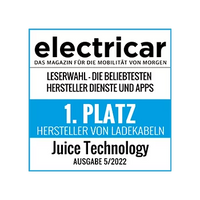The term “range anxiety” describes a driver’s feeling of not being able to reach their destination or the next charging point in time due to the insufficient range of their electric car and consequently getting stranded.
In this article we explain why this fear is more than unfounded today and how it can easily be cured with a little background knowledge.
The chapters at a glance
- Where does range anxiety come from?
- How can you overcome this range anxiety? 3 tips
- Conclusion
Where does range anxiety come from?
Range anxiety is often based on the false idea that an electric car either does not have enough range for a specific purpose, or that it takes too long to charge, since in an emergency you cannot simply pour ten liters of fuel from the reserve canister into the tank.
The fact is: the average European now drives a distance of 40 to 60 km per day, which even the small electric car models can easily manage. This should cover the majority of all potential drivers and free them from their range anxiety.
This feeling can also arise if you assume that there are only ten charging stations in the whole country that you have to find first. Not to forget the fear that the long charging time will condemn you to do nothing and count the seconds.
How can you overcome this range anxiety?
You don't have to worry, because here are 3 tips on how you can throw these worries overboard without a prescription.
Tip #1: Know what affects your reach
The following factors influence the range of an electric car
Speed: As with combustion engines, the laws of physics also apply to electric vehicles: the faster you want to drive, the more energy is consumed. So if you want to get the greatest range from your battery, you should refrain from pressing the accelerator pedal all the way down without stopping.
Regenerative braking: A major and often overlooked advantage of electric cars is the technology of regenerative braking. Simply put, range is gained every time the electric car coasts or “brakes” with the engine. Our CEO Christoph Erni drove up the Gotthard Pass and then down towards Italy, gaining a full 50 kilometers of range over an 80-kilometer journey!
Cold weather: With today's battery technology, a reduction in range must be expected in winter at temperatures below 0 °C. However, the extent to which this is the case varies from model to model. One decisive factor is the heating of the interior - depending on how warm you want it to be as an electric car driver.
On the other hand, the built-in battery also needs to be brought up to temperature in winter to function optimally - the decisive factor for energy consumption here is the built-in heating technology, which is responsible for the temperature management of the battery. In extreme cases, you can expect a reduction in range of around 30%. However, this is not an electric phenomenon. Petrol vehicles also consume an average of 15% more in winter, and diesel around 24%.
Tip No. 2: Know your charging options
Thanks to solutions like the Juice Booster 2, the electric car can be charged anywhere there is a power source - from industrial sockets to household sockets. If you count all possible power sources as charging points, there are already over 60 million charging points in Germany alone.
If you commute to work with a full battery, you can charge it up again at your employer's, for example. When you get home, you charge it overnight and are greeted by a full battery in the morning. And if you are planning a longer trip, the smart app on your smartphone will help you find public charging points and fast charging stations along the route so that you can combine charging with a short break and a trip to the toilet.
The ADAC recommends taking a break of at least 15 minutes after 2 hours of driving, regardless of the type of drive. At a quick-charging point, the battery of many models can be recharged by 40% in this time. Enough to get you to the next stop!
Tip No. 3: Choose the right vehicle
As already mentioned at the beginning, choosing the right model depends on the driver’s personal needs.
If it is clear in advance that longer distances will have to be covered frequently, it makes sense to choose a model with a long range and strong charging capacity.
Conclusion:
If you want to travel longer distances in an electric car or go on a trip with it, you still have to plan your route a little better today. Short distances (which are common for most consumers) can already be managed easily today thanks to the increasing expansion of the charging infrastructure, increasing vehicle ranges and available charging solutions at home and at work. The advantage of this is that you even save yourself the extra trip to the gas station, because you can then have it where the vehicle is parked for a longer period of time anyway.













